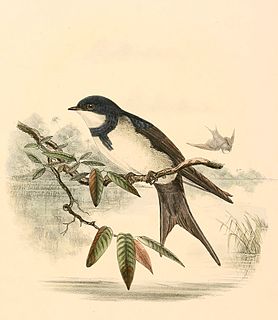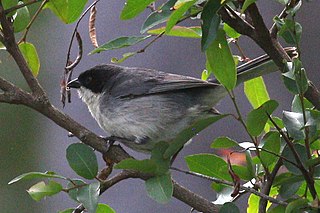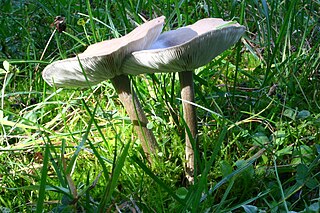
The greater yellowlegs is a large North American shorebird. The genus name Tringa is the New Latin name given to the green sandpiper by Aldrovandus in 1599 based on Ancient Greek trungas, a thrush-sized, white-rumped, tail-bobbing wading bird mentioned by Aristotle. The specific melanoleuca is from Ancient Greek melas, "black", and leukos, "white".

Ailuropoda is the only extant genus in the ursid (bear) subfamily Ailuropodinae. It contains one living and three fossil species of panda.

The wonga pigeon is a pigeon that inhabits areas in eastern Australia with its range being from Central Queensland to Gippsland, eastern Victoria, Australia.

The red-billed pied tanager is a small passerine bird, a member of the family Mitrospingidae. It is the only member of the genus Lamprospiza.

Naja is a genus of venomous elapid snakes known as cobras. Several other genera include species commonly called cobras, but members of the genus Naja are the most widespread and the most widely recognized as "true" cobras. Various species occur in regions throughout Africa, Southwest Asia, South Asia, and Southeast Asia.

The Qinling panda is a subspecies of the giant panda, discovered in the 1960s but not recognized as a subspecies until 2005. Disregarding the nominate subspecies, it is the first giant panda subspecies to be recognized. It differs from the more familiar nominate subspecies by its smaller skull and dark brown and light brown fur, and its smaller overall size. There are an estimated 200–300 Qinling pandas living in the wild.
On August 30, 1989, a female of this species was captured and brought to the Xi'an Zoo to be mated with a regular giant panda. Her offspring was black-and-white, but reportedly started becoming brownish as it aged. According to other reports she gave birth to three cubs but all of whom died shortly after being born. The mother, named Dan-Dan, died in 2000.
This subspecies is restricted to the Qinling Mountains, at elevations of 1,300–3,000 metres (4,300–9,800 ft). Its coloration is possibly a consequence of inbreeding: as the population is closed off from genetic variation and this might have led to the preservation of the mutation responsible.

Ailuropodinae is a subfamily of Ursidae that contains only one extant species, the giant panda of China. The fossil record of this group have shown that various species of pandas were more widespread across the Holarctic, with species found in places such as Europe, much of Asia and even North America. The earliest pandas were not unlike other modern bear species in that they had an omnivorous diet but by around 2.4 million years, pandas have evolved to be more herbivorous.

Atticora is a genus of bird in the swallow family Hirundinidae. These species are found in South America.

The black-collared swallow is a species of bird in the family Hirundinidae.
It is found in Argentina, Bolivia, Brazil, Colombia, French Guiana, Guyana, Paraguay, Suriname, and Venezuela.
Its natural habitat is rivers.

Heterophasia, the sibias, is a bird genus in the family Leiothrichidae.

The black-and-white triller is a species of bird in the family Campephagidae. It is endemic to the Philippines.

The black-capped warbling finch is a species of bird in the family Thraupidae.
It is found in Argentina, Bolivia, Brazil, Paraguay and western Uruguay.
Its natural habitats are subtropical or tropical dry forests, subtropical or tropical dry shrubland, and subtropical or tropical high-altitude shrubland.

Melanoleuca is a poorly known genus of saprotrophic mushrooms traditionally classified in the family Tricholomataceae. Most are small to medium sized, white, brown, ocher or gray with a cylindrical to subcylindrical stipe and white to pale yellowish gills. The basidiospores are ellipsoid and ornamented with amyloid warts. Melanoleuca is considered a difficult group to study due to their macroscopic similarities among species and the need of a thorough microscopic analysis to separate species. DNA studies have determined that this genus is closely related to Amanita and Pluteus and that it does not belong to the family Tricholomataceae.
A. melanoleuca may refer to:
H. melanoleuca may refer to:
L. melanoleuca may refer to:

The forest cobra, also commonly called the black cobra and the black and white-lipped cobra, is a species of venomous snake in the family Elapidae. The species is native to Africa, mostly the central and western parts of the continent. It is the largest true cobra species with a total length of up to 3.1 meters. Although it prefers lowland forest and moist savanna habitats, this cobra is highly adaptable and can be found in drier climates within its geographical range. It is a very capable swimmer and is often considered to be semi-aquatic. The forest cobra is a generalist in its feeding habits, having a highly varied diet: anything from large insects to small mammals and other reptiles. This species is alert, nervous and is considered to be a very dangerous snake. When cornered or molested, it will assume the typical cobra warning posture by raising its fore body off the ground, spreading a narrow hood, and hissing loudly. Bites to humans are less common than from other African cobras due to various factors, though a bite from this species is a life-threatening emergency.
Melanoleuca privernensis is a species of fungus in the Pluteaceae family. It was originally named Kinia privernensis in 2008 and a new genus Kinia was erected to contain it. Two years later, molecular analysis showed that it was closely related to Melanoleuca, and Kinia was reduced to a subgenus of Melanoleuca.

Melanoleuca melaleuca is a species of mushroom in the Tricholomataceae family, and it is the type species of its genus Melanoleuca. It is difficult to distinguish from other related species firstly because it is variable, secondly because the taxonomic criteria are often based on characteristics which have later been found to be variable, and thirdly because there is much disagreement between authorities as to exactly how the species should be defined.
Eucalyptus melanoleuca, commonly known as yarraman ironbark or nanango ironbark, is a eucalypt that is native to Queensland.

















